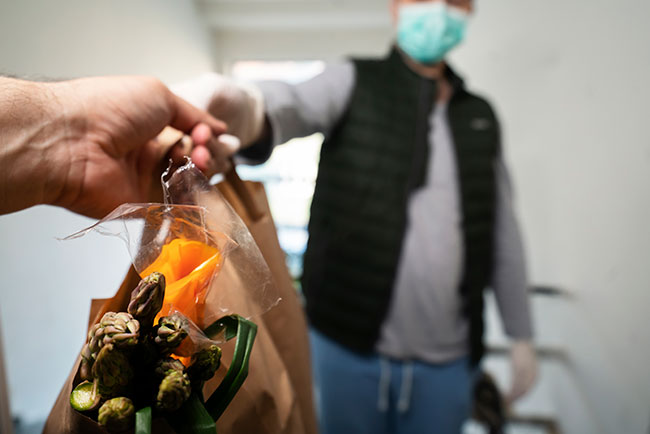••• advertising research
Just a temporary lull
COVID-19 won’t slow digital ad spend
 Although the COVID-19 pandemic slowed the growth of digital advertising, online ads were still expected to increase their market share in 2020, according to data from Buy Shares. After a sharp fall in ad spending in March, the last few months of 2020 witnessed strong growth across all regions, as millions of consumers shifted to websites and online retailers from brick-and-mortar stores. According to the study, the trend is expected to continue in 2021, with global ad spending growing by 14% year over year to $395 billion.
Although the COVID-19 pandemic slowed the growth of digital advertising, online ads were still expected to increase their market share in 2020, according to data from Buy Shares. After a sharp fall in ad spending in March, the last few months of 2020 witnessed strong growth across all regions, as millions of consumers shifted to websites and online retailers from brick-and-mortar stores. According to the study, the trend is expected to continue in 2021, with global ad spending growing by 14% year over year to $395 billion.
In 2017, brands and media buyers spent $251.7 billion on digital advertising worldwide, revealed Statista Digital Market Outlook. Over the next two years, this figure jumped by 33% to $335.7 billion. However, the pandemic triggered a sharp fall in ad spending between January and March 2020, as one-quarter of media buyers and brands paused their budgets in a time of economic uncertainty. Nevertheless, many of them adapted to a new environment where businesses and consumers were getting used to living with COVID-19 and adjusted their budgets in response. As a result, global digital ad spending was expected to grow 3% year over year to $345.9 billion in 2020.
Statistics show that ad spending in the classifieds segment is expected to drop by 2.1% year over year to $18.5 billion in 2020. By the end of 2021, this figure will jump over $19.7 billion
Video ad spending was projected to rise by 4.1% year over year to $27.8 billion in 2020. Over the next 12 months, this figure is expected to jump to $30.9 billion. Banner ad spending is forecast to hit $58.6 billion in value in 2021, a $6.5 billion increase year over year.
Statista data indicate the search advertising segment is expected to witness the most significant boost in spending and grow from $148.5 billion in 2020 to $172.2 billion in 2021, a 16% jump year over year. The social media ad spending follows with a 15% year-over-year increase to $113.6 billion in 2021. Statistics show the global digital ad spending will continue growing in the following years and hit $447.4 billion in value by 2023.
Recent years have witnessed a surge in the use of mobile phones, which had a significant impact on the digital advertising industry. To keep up with consumer demands, generate higher revenues and boost their brand name, companies had to create user-friendly mobile ads.
In 2017, 45% of the total digital advertising spending was generated through mobile devices. Mobile advertising continued growing in the last three years and hit a 55% market share in 2020. Statistics show this figure is set to jump to 57% in 2021 and by the end of 2022, mobile ads will account for almost 60% of total digital ad spending.
Analyzed by geography, the United States represents the world’s leading digital advertising industry, expected to hit $129.4 billion in spending in 2020, a 0.3% drop in a year. However, this figure is forecast to jump by 17% and reach $151.5 billion in 2021.
Digital ad spending in China, as the second largest market globally, is expected to grow by 9% year over year to $77.7 billion in 2020. The United Kingdom, Japan and Germany follow with $21.8 billion, $15.8 billion and $9.8 billion, respectively.
Statistics show the combined ad spending in the top five digital advertising markets is expected to jump by 14.5% year over year and hit $291.5 billion value in 2021.
••• small business research
The long haul
Women-owned businesses suffer under pandemic strain
 COVID-19 has caused incredible strain for business owners across the U.S. and globally. KeyBank surveyed women business owners to better understand their personal outlook and found that confidence is falling compared to previous years of conducting the same survey. In two years, the number of respondents who say they are confident in their personal finances in the future experienced a 22% drop. Another 23% drop occurred for business owners who say they are confident in the financial health of their business over the last two years.
COVID-19 has caused incredible strain for business owners across the U.S. and globally. KeyBank surveyed women business owners to better understand their personal outlook and found that confidence is falling compared to previous years of conducting the same survey. In two years, the number of respondents who say they are confident in their personal finances in the future experienced a 22% drop. Another 23% drop occurred for business owners who say they are confident in the financial health of their business over the last two years.
About one in three women-owned small businesses have low optimism that they will achieve their business goals over the next year, mostly due to the pandemic and economy. Six in 10 women business owners report the pandemic directly impacted their business negatively. Among all respondents, the effects of the pandemic are creating three big challenges that stand out: 40% cite adjusting to a new operating model while 36% say they are having trouble attracting customers and another 36% say they are having trouble maintaining staff productivity.
For one in four women-owned businesses right now, cash-flow management is a problem. Without that flow, many businesses are putting expansion plans on hold. In 2019, 90% of respondents said they planned to expand within the next two years. That has now dropped to approximately three-quarters.
Confidence in the financial abilities of businesses is also falling. The ability to handle accounting and finances is down 11% from 2019, while the confidence in ability to obtain credit is down 13% and the confidence in ability to conduct negotiations is down 10% in one year.
Optimism has also faded among women business owners with age playing a critical factor in the responses KeyBank found. Overall, while only 46% of the total businesses surveyed were confident about achieving their goals over the next year, down from 71% just two years ago, it was Millennial business owners who had more optimism. Sixty percent of those under the age of 35 were optimistic about the future.
In August 2020, respondents gave their best estimates for when they thought business will return to normal for themselves, with a minority saying one to three months (5%) and others reporting four to six months (22%), seven to 12 months (32%) and more than a year (25%). Three percent of respondents said that business may never return to normal for them, while 8% said that it’s already returned to normal and 7% reported that their business was not affected by the pandemic.
The survey was conducted by Schmidt Market Research with a third-party panel, Dynata, gathering results from 305 total respondents. The survey was conducted in August 2020.
••• employment research
I, co-worker
Automation eases business processes during COVID-19
 The ABBYY Global COVID-19 Technology Survey investigated the impact of COVID-19 and automation technologies on office workers in 20 industries across the U.S., U.K., France and Germany.
The ABBYY Global COVID-19 Technology Survey investigated the impact of COVID-19 and automation technologies on office workers in 20 industries across the U.S., U.K., France and Germany.
The study found that three-quarters (74%) of workers experienced challenges since the pandemic began, with one in four wanting to quit their job because of poor business processes. Nearly half of staff (48%) blamed bad processes for making their job more challenging – with a third saying they waste time. When identifying the cause of their biggest challenges, 40% of workers blame a lack of information on solutions or tasks, while 32% blamed not having the right IT tools.
In asking what tools could make their job better, the top three answers were communications tools (70%), task monitoring (43%) and AI (39%).
Software robots are being used by 46% of respondents, who reported that they spend up to two hours a day with their digital co-worker. Of those working with digital co-workers, 34% said they were most helpful at sorting and classifying data and documents. Sixty-four percent of companies adopted new technologies and processes for the first time during the lockdown to help alleviate the stresses of remote working. Those using digital workers estimate that they save them an average of 26 hours a week in productivity.
Those who wished they had a digital co-worker said they would use them for digitizing paper, prompts and classification purposes and could save 54 days per year using a digital colleague.
As the survey results show, organizations continue to face rising challenges when it comes to quickly and accurately processing content such as documents, forms, images and e-mail communications. The survey revealed that 76% of tools used to help with processes, digitizing the automation and content within paper and onboarding new clients were deemed successful for respondents, including tools for monitoring employees’ tasks. This points to the growing trend of many organizations that are now turning to technologies like content intelligence, process mining and task mining to support their digital transformation efforts.
The survey was conducted by Opinium on behalf of ABBYY in November 2020 and surveyed 4,000 office workers in the U.S., U.K., Germany and France.
••• nonprofit research
Holding steady
Organizations maintain 403(b) practices during pandemic
 A snapshot survey by the Plan Sponsor Council of America has found that the vast majority (83.6%) of nonprofit organizations with 403(b) plans are holding steady and not changing their contribution levels despite the financial pressures of the COVID-19 pandemic.
A snapshot survey by the Plan Sponsor Council of America has found that the vast majority (83.6%) of nonprofit organizations with 403(b) plans are holding steady and not changing their contribution levels despite the financial pressures of the COVID-19 pandemic.
Some nonprofit organizations plan to suspend matching contributions (6.3%), suspend non-matching contributions (4.1%), reduce matching contributions (3.4%) or reduce non-matching contributions (3.4%).
While the majority of organizations did not plan to change employer contributions in 2020, nearly a third of higher education institutions said they either have, or would by year-end, reduced or suspended contributions to their 403(b) plans. Ten percent of all respondents suspended or reduced the matching contribution and 7.5% suspended or reduced the non-matching contribution.
Nonprofit organizations across industries noted an increase in hardship withdrawals since COVID-19, including health care and hospitals (52.2%); higher education, including faith-based (36.0%); research, science or environmental (31.3%); K-12 education (18.5%) and other (15.8%).
Similarly, while three-fourths of plans indicated they had not noted an increase in plan loan activity since the beginning of COVID-19, just more than a third (36.0%) of hospitals and health care organizations noted an increase, as did nearly 30% of higher education institutions. However, those sectors were a relatively small sampling of the overall survey.
While more than 70% of organizations reported no change in the volume of hardship and in-service withdrawals for 2020, more than half (52.2%) of hospital and health care systems did cite an increase in participants tapping their accounts. More than a third of higher education institutions also noted an increase.
The study was conducted by the Plan Sponsor Council of America and surveyed 300 nonprofit organizations in October 2020.
••• grocery research
Shift to online
Shopping habits will continue after pandemic
An Oracle Grocery Retail survey shows that 53% of respondents in the U.S. have shopped online for groceries during the pandemic, with 37% stocking up more frequently online than in-store. Few people plan to reverse course – 93% of those surveyed said they plan to shop online for groceries post-pandemic, with 74% noting they will order groceries the same amount or more as they are doing currently.When it comes to online grocery ordering, the vast majority of consumers opt for home delivery. Seventy-two percent have groceries delivered to their home, 13% pick them up inside the store and 15% collect their groceries curbside.
A significant percentage of all age groups surveyed have ordered groceries online during the pandemic, with Generation X leading the way (72%). Gen Z also favors this route, with 61% of this cohort ordering groceries online, along with 60% of Millennials and 30% of Baby Boomers. Although Boomers represented the lowest total overall, this age group saw a 173% increase in those who had ordered groceries during COVID-19 versus before the pandemic. Moreover, 83% of this demographic plan to continue ordering groceries online. Interestingly, those with kids were also more than twice as likely to order groceries online (82%) versus those without children (36%).
With grocery shortages during the pandemic, 86% of shoppers explored store-owned brands and private-label alternatives, with some having no plans of returning to their old favorites. Thirty-two percent intend to stick with the store brands while 34% will shop a mix of new finds and preferred brands and 20% will go back to preferred brands.
Despite COVID-19 winter warnings, shoppers are worrying less about shortages of essential items. Just 28% of those polled are planning to stockpile household essentials and pantry staples, including toilet paper (69%), cleaning products (69%), canned fruits and vegetables (54%), meat (50%), soup (48%), pasta (48%) and rice (46%).
With more shoppers eating at home and looking for inspiration, meal subscriptions have increased, with 22% continuing a food or meal subscription they already had, 10% already enjoying one food or meal subscription service and adding another and 4% starting a new food or meal subscription for the first time.
The Untold Insights survey was conducted on behalf of Oracle Retail and polled 521 U.S. consumers in September 2020 and another 500 in November 2020.
••• travel/leisure research
Packed and (almost) ready
Australian travelers react to current and future rules, restrictions
 Over a third (34%) of Australian travelers have already considered booking somewhere to stay in order to work from a different destination, while two in five (43%) would be willing to quarantine if they could work remotely, according to 995 Australian respondents surveyed by Booking.com as part of a worldwide survey of 20,000 travelers.
Over a third (34%) of Australian travelers have already considered booking somewhere to stay in order to work from a different destination, while two in five (43%) would be willing to quarantine if they could work remotely, according to 995 Australian respondents surveyed by Booking.com as part of a worldwide survey of 20,000 travelers.
Working remotely has irreversibly entered the mainstream during the pandemic, with the effect that people will look to take longer trips in the future that more effectively combine work and pleasure. Accommodations will prioritize showcasing home office facilities in an attempt to attract this new wave of digital nomads. Likewise, the world of corporate travel will see increasing demand for privacy, cleanliness and longer stays among those traveling for business, requiring alternative accommodations to up their “work-friendly” game. While companies will undoubtedly reassess their approach to business travel in the future, workers will continue to maximize the trips they do take, with half of Australian travelers (50%) saying they would take the opportunity to extend business trips to enjoy leisure time at the destination.
With 41% of Australian travelers wanting to travel more sustainably in the future, travelers are likely to develop a more eco-conscious mind-set, as COVID-19 has increased consumers’ awareness about responsible choices. Two-thirds (62%) expect the travel industry to offer more sustainable travel options and travelers will consequently visit alternative destinations in a bid to avoid traveling during peak season (52%) and times of overcrowding (50%). Additionally, COVID-19 has inspired more than half (52%) of travelers to consider reducing waste and/or recycling their plastic when traveling again.
Australian travelers believe that the industry must adapt to this sustainable mind-set by offering more attractive off-season travel packages (47%) and proposing alternative destinations to prevent overcrowding (32%). Over two-thirds (68%) of Australians indicate that they want their travel choices to also support the destination’s recovery efforts and more than half (54%) want to see how their money is going back into the local community.
Tech innovation will adapt to a new type of traveler and will play a crucial role in rebuilding traveler confidence. Already, six in 10 Australian travelers agree that technology will be important in controlling health risks when traveling and 61% say that accommodations will need to use the latest technologies to make travelers feel safe. Almost half (46%) will want tech options to make last-minute restaurant reservations and about the same amount (48%) will want more self-service machines instead of ticket desks. Forty-seven percent are also excited about tech’s potential to further personalize their travel experiences in the future. Almost three in 10 (29%) would feel more comfortable about going to an unknown destination if they could scout it beforehand using virtual reality.
The financial legacy of COVID-19 will inevitably see people demand more bang for their buck in the future. Sixty-three percent of Australian travelers will be more price-conscious when it comes to searching and planning a trip in the future and 53% are more likely to hunt down promotions and savings, behaviors that will likely last years.
But the value consumers expect will go beyond price tags; three-quarters (74%) stated they want travel booking platforms to increase their transparency about cancellation policies, refund processes and trip insurance options. Furthermore, 51% consider refundable accommodation a must-have for their next trip, as do almost half (38%) when it comes to the flexibility to change dates without being charged. Travelers are keen to support the industry in its recovery (71%) and want their future bookings to help rebuild communities around Australia and the world (68%).
Almost three in four Australian travelers (74%) will take more precautions due to COVID-19 and will look to the travel industry to help them gear up for this new normal. Sixty-five percent of travelers will avoid certain destinations (rising to 67% of Baby Boomers) and 72% expect tourist attractions to adapt to allow for social distancing. At the same time, 65% will only book a particular accommodation if it’s clear what health and hygiene policies it has in place.
Short-term, there will also be a change in transport preference and provisions, with under half (41%) opting to avoid public transport. This will cause a longer-term shift in how people will travel to and around their vacation destinations, with more people choosing to rent or drive their own car. Just as we have become accustomed to traveling without liquids in our carry-on luggage and removing shoes to go through airport security, 62% will accept traveling to destinations that have health spot checks on arrival and 42% will accept wearing a mask in public. Quarantine measures will remain less popular, with far fewer (27%) travelers willing to accept these in order to travel to a particular destination.
Research was commissioned by Booking.com in July 2020 and was conducted among a sample of adults who had traveled for business or leisure in the previous 12 months and planned to travel in the next 12 months (if/once travel restrictions are lifted). In total 20,934 respondents across 28 countries were polled, including 995 from Australia.
